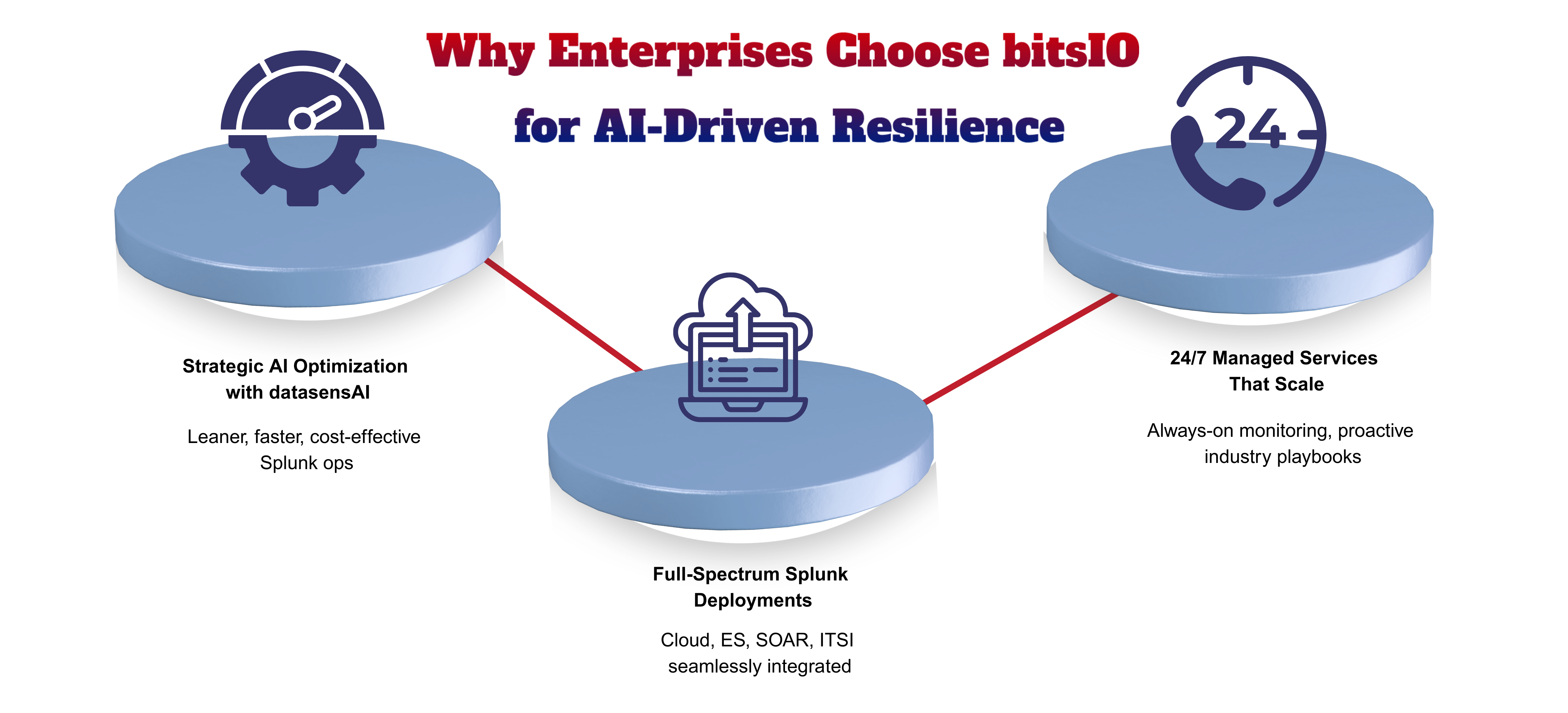Summarize the Content of the Blog
Over the past three years, the gap between digitally mature companies and those lagging has widened by 60%. Executives at data-driven organizations are now nearly three times more likely to report meaningful improvements in strategic decision-making compared to peers who have not made this shift.
However, as digital maturity accelerates, cyber threats are evolving even more rapidly. Multi-cloud setups, expanding machine data, and siloed tools are creating alert fatigue and critical blind spots for security teams, challenges that traditional systems can no longer solve.
This is where Splunk digital resilience becomes essential.
With the rise of AI and machine learning, forward-looking companies are gaining the ability to anticipate, absorb, and adapt to threats across IT, security, and business operations. Splunk’s 2025 AI/ML roadmap reflects this new reality. It introduces more intelligent automation, Retrieval-Augmented Generation (RAG), and industry-specific AI assistants designed to shift security teams from reactive response to proactive defense.
Building Splunk Digital Resilience Across Hybrid Clouds
Keeping systems running in today’s hybrid cloud environments isn’t easy. Applications and data are now spread across public clouds, private data centers, and edge devices. The average cost of IT downtime exceeds $300,000 per hour, and this number rises sharply in industries such as banking, healthcare, and manufacturing. For most organizations, this leads to more complex monitoring and costlier mistakes.
Splunk defines digital resilience as more than just uptime. It can:
- Detect risks early across IT, security, and business systems
- Respond to incidents quickly and with context
- Adapt to changing threats and recover without business disruption
This is especially important in hybrid cloud setups, where different parts of the business rely on different platforms. Splunk’s digital resilience tools ensure system uptime and security by combining:
- Security analytics from Security Information and Event Management (SIEM) and Security Orchestration, Automation and Response (SOAR)
- AI to connect fragmented alerts and highlight only what matters
- Observability across infrastructure, applications, and user experience
- Automation to cut down human effort and speed up response, powered through a single data platform
AI also plays a key role in making systems smarter. Over time, it builds context, learns patterns, and can even predict disruptions before they impact users. Overall, Splunk digital resilience helps enterprises respond faster, is twice as likely to be prepared to handle digital disruption, and achieves $48 million in annual cost savings by minimizing unplanned downtime.
What’s New in Splunk’s 2025 AI/ML Plan?
Splunk’s 2025 roadmap brings powerful AI/ML upgrades to boost digital resilience in today’s fast-changing environments.
- At the core of these updates are AI assistants built into both Splunk Observability Cloud and Splunk Security Cloud. These assistants help teams respond faster by summarizing anomalies, suggesting next steps, and even drafting queries, which significantly cuts time spent on manual investigation.
- In Splunk ITSI, a new feature called Drift Detection tracks changes in service behavior over time. This allows teams to catch silent failures before they escalate into bigger issues, which is essential in hybrid setups where early warning signs can be easily missed.
- Another standout is Retrieval-Augmented Generation (RAG), which combines AI with real-time data access. Instead of relying on static models, RAG pulls the latest context from your Splunk environment to improve threat analysis and incident response. This ensures AI decisions are grounded in current, relevant data.
- Finally, the Machine Learning Toolkit (MLTK) now supports more use cases straight out of the box, helping analysts detect patterns, forecast risks, and reduce alert noise without needing deep coding skills.
How Splunk AI/ML Drives Real Outcomes

Splunk’s AI/ML tools do not limit themselves to predictions alone. They drive real impact across industries. From retail and utilities to healthcare and manufacturing, organizations are leveraging intelligent automation to address problems that traditional systems cannot handle.
Today, resilience means speed, accuracy, and adaptability, and every AI/ML enhancement in Splunk contributes to building a resilient digital infrastructure.
Smarter threat detection in complex environments
Cyber threats today are more advanced. Attackers now mimic normal user behavior, making traditional rules-based systems less effective.
Splunk’s Machine Learning Toolkit (MLTK) helps security teams build models that learn how systems behave and flag unusual activity. These models profile user behavior in real time, catching subtle threats before they escalate.
For organizations that require tailored detection, partners like bitsIO help extend these capabilities further by building custom pipelines and tuning detection models to meet industry-specific needs. Combined with Splunk’s ability to ingest third-party threat intelligence, this results in context-rich alerts that highlight real threats, not noise.
One example of this in action is a leading semiconductor manufacturer that worked with bitsIO to upgrade its hybrid security operations using Splunk Cloud and Enterprise Security.
Automating incident response at scale
Once a threat is detected, Splunk SOAR uses AI to assess severity and trigger automated responses without waiting for manual input. Playbooks are launched instantly depending on the severity of the issue.
This is essential for SOC teams operating 24/7. With low-code automation, incidents can be handled quickly, even without deep technical expertise. Partners like bitsIO help organizations fine-tune these playbooks to match specific operational and industry needs.
This approach helped a major U.S.-based pizza chain shift from reactive fixes to proactive incident response across its store network.
Achieving continuous compliance with AI
With increasing regulations, companies need live dashboards and real-time oversight. Splunk’s AI tools are built to support this need, helping teams stay compliant and responsive at all times.
- Natural Language Processing (NLP) converts raw audit logs into plain-language summaries that regulators can understand.
- Pattern recognition filters out noise and flags actual violations.
- Additionally, with its dynamic dashboards, businesses can track readiness for SOC 2, HIPAA, PCI-DSS, or GDPR compliance, down to the control level, without waiting for an audit.
bitsIO helped a global healthcare client put this into practice by migrating legacy Splunk data to the cloud, enabling faster audits and stronger compliance.
Why Enterprises Choose bitsIO for AI-Driven Resilience
Splunk’s 2025 roadmap sets a clear direction for AI-driven digital resilience. But having the right tools isn’t enough. Most enterprises struggle with implementation, scaling, and daily optimization. That’s where bitsIO steps in as a strategic partner that brings Splunk’s AI vision to life across industries.
Here’s how bitsIO makes AI-driven resilience best suited for the real world:
1. Strategic AI Optimization with datasensAI
bitsIO’s proprietary platform, datasensAI, ensures you get the most out of your Splunk setup by:
- Tuning data ingestion to reduce volume without sacrificing visibility
- Optimizing license usage to stay within budget while maintaining performance
- Analyzing usage to identify underused dashboards and noisy alerts that affect efficiency
This leads to leaner, faster, and more cost-effective operations.
2. Full-Spectrum Splunk Deployments
bitsIO delivers end-to-end deployments of:
- Splunk Cloud Platform
- Enterprise Security (ES)
- SOAR for incident response
- ITSI for service monitoring and drift detection
With seamless integration across CMDB, SAML, and CI/CD pipelines, bitsIO guarantees your systems work together.
3. 24/7 Managed Services That Scale with You
From KPI dashboarding to continuous tuning, bitsIO provides always-on support:
- Real-time monitoring with SLA-backed response
- Proactive addressing of issues before they impact business
- Customized playbooks tailored by industry (for example, healthcare, insurance, retail)
Conclusion
As we move further into 2025, it’s clear that AI and machine learning are no longer optional but essential for building digital resilience. To stay ahead, security leaders must modernize their approach to detection, response, and compliance. In this journey, bitsIO offers the right support through a data-led strategy tailored for today’s challenges.
With deep expertise in Splunk Cloud, ES, SOAR, and ITSI, and backed by its optimization platform, datasensAI, bitsIO helps organizations build, train, and maintain AI/ML-powered frameworks that scale. From reducing alert fatigue to automating response and maintaining continuous compliance, bitsIO helps teams get the most out of Splunk digital resilience in complex enterprise environments.















